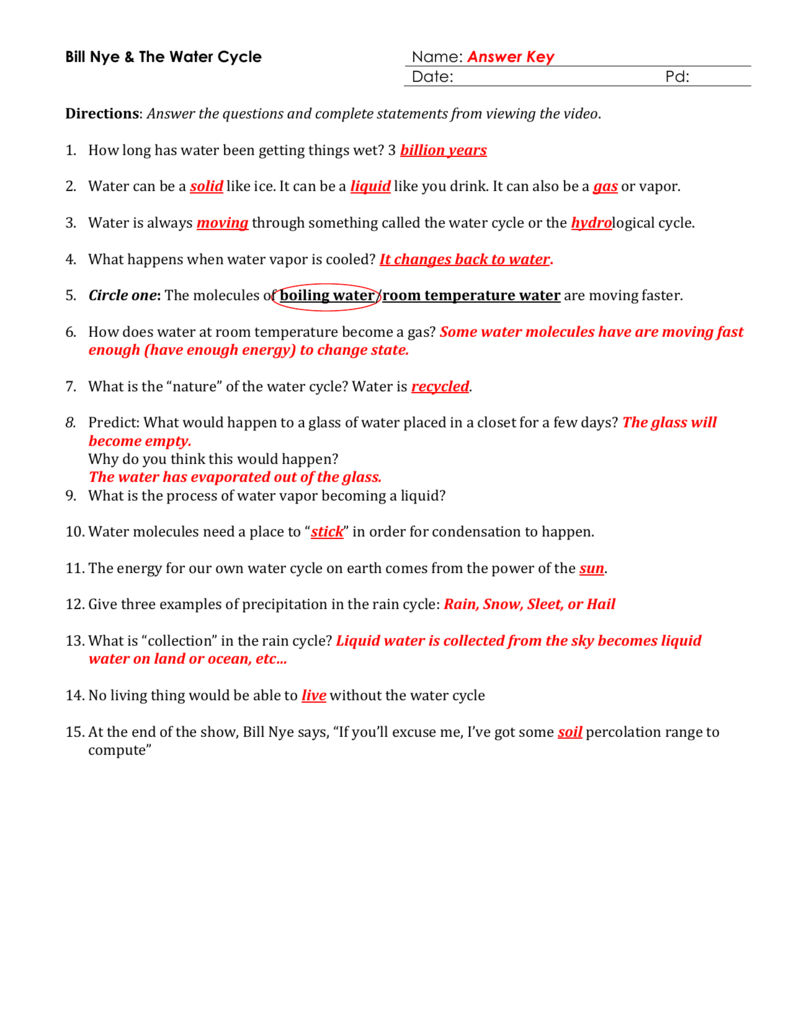Do you ever wonder where the water in your glass came from? Or how the raindrops falling from the sky replenish the rivers and lakes? The answer lies in the fascinating and ever-present cycle of nature: the water cycle. From the tiniest puddle to the vast oceans, water is constantly moving and transforming, driven by the energy of the sun.

Image: davida.davivienda.com
Bill Nye, the science communicator extraordinaire, has helped generations understand the world around them through his engaging and entertaining approach to science. And the water cycle, with its mesmerizing journey of evaporation, condensation, precipitation, and collection, is a perfect example of a natural phenomenon that Bill Nye has expertly brought to life.
A Journey Through the Water Cycle
Evaporation: From Liquid to Vapor
Imagine a puddle on a sunny day. As the sun’s rays warm the water, its molecules start to jiggle and wiggle. Some of these molecules become energetic enough to break free from the liquid and escape into the air as water vapor. This process, called evaporation, is like a giant invisible hand lifting water from the Earth’s surface and carrying it into the atmosphere.
Condensation: From Vapor to Clouds
As the water vapor rises higher, it encounters cooler temperatures. This cooling causes the water vapor molecules to slow down and eventually clump together, forming tiny droplets of liquid water. These droplets are too small to fall as rain but gather together in the sky, forming fluffy white clouds. This process is called condensation, where water vapor changes back into its liquid form.

Image: www.teacherspayteachers.com
Precipitation: Rain, Snow, Hail, and More
As clouds continue to grow and water droplets accumulate, the droplets eventually become heavy enough to fall back to Earth. This is called precipitation, and it can take many forms, depending on the temperature and conditions. When the air is warm, we get rain. If it’s colder, we get snow, sleet, or hail. Precipitation is the lifeblood of the planet, replenishing freshwater sources and sustaining life.
Collection: Completing the Cycle
Once the precipitation reaches the Earth’s surface, it flows into rivers, lakes, and oceans, or soaks into the ground. Some of the water evaporates back into the atmosphere, restarting the cycle. Other water is absorbed by plants and animals, providing essential nourishment for all living things. This process, called collection, marks the end of one journey and the beginning of another.
Bill Nye’s Explanation: Simple and Engaging
Bill Nye’s approach to explaining the water cycle is renowned for its clarity and humor. He effectively uses everyday objects and analogies to illustrate complex scientific concepts. For example, he likened the process of evaporation to boiling water in a pot, showcasing how heat transforms liquid water into vapor.
In one of his famous experiments, Bill Nye demonstrated condensation by placing a glass filled with ice water on a warm surface. The cold glass caused the air surrounding it to cool, leading to condensation on the glass. He then used this experiment to bridge the connection between condensation and cloud formation.
The Importance of the Water Cycle
Understanding the water cycle is crucial for a multitude of reasons. It’s the foundation of our planet’s climate, influencing weather patterns, water availability, and ecosystem health. The water cycle is also intricately linked to human activities, such as agriculture, industry, and energy production.
As a global community, we face challenges like water scarcity and pollution. By understanding the complexities of the water cycle, we can develop sustainable practices to manage our water resources and protect our planet for future generations. Bill Nye’s engaging approach to science empowers us all to become better stewards of our environment.
Beyond the Basics: Exploring the Nuances
While the basic water cycle framework is relatively straightforward, the real world is much more dynamic. Factors like temperature, wind patterns, and topography play significant roles in influencing the water cycle’s intricate workings.
For instance, mountains can act as barriers to air currents, causing precipitation on one side and dryness on the other. Similarly, evaporation rates differ across various geographical regions, impacting local weather patterns and water availability.
Bill Nye’s Legacy: Inspiring a Future Generation of Scientists
Bill Nye’s passion for science and his ability to make complex concepts accessible to everyone have left an enduring mark on generations of learners. His emphasis on critical thinking, experimentation, and scientific literacy has inspired countless young minds to pursue careers in STEM fields.
His contributions extend beyond television. Bill Nye has actively advocated for science-based policy decisions, emphasizing the importance of evidence-based reasoning in tackling global challenges. His work has cemented his status as a champion for scientific inquiry and a powerful voice for promoting understanding of the natural world.
Bill Nye The Science Guy Water Cycle
Conclusion: A Journey of Discovery Continues
From Bill Nye’s engaging explanations to our own everyday observations, the water cycle reminds us that we live in a constantly changing and interconnected world. It’s a reminder of the sheer power and magnificence of nature, reminding us of our responsibility to protect and preserve this vital cycle for future generations. As we continue to unravel the mysteries of our planet, Bill Nye’s legacy of science education continues to guide us, inspiring us to explore, learn and ultimately make a difference.






